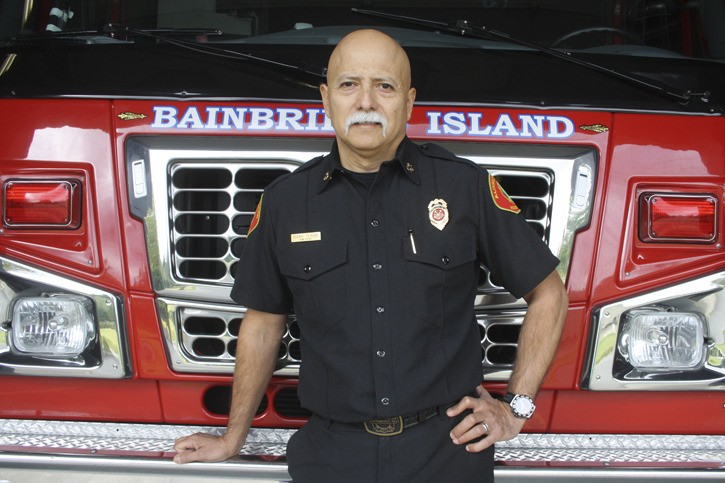Contemplating disaster isn’t at the top of most people’s list of how to spend a Monday evening, but for the roughly 50 people who gathered at the Bainbridge Commons this week, the evening proved informative.
“I’m not going to blow smoke here – pardon the pun – and say we’re ready,” said Bainbridge Island Fire Department Chief Hank Teran. “We’re not.”
In July implementation of the island’s Disaster Response plan shifted from the Police Department to the Fire Station.
Building on previous work done by the city, and partnering with other organizations, BIFD has assembled a five-year plan to help deal with the seven different types of potential emergencies possible on Bainbridge. The list tackles troubles from mild to extreme, but there is good news.
“We get to practice every year when the power goes out,” he joked.
If last winter’s five-day power outage is any indication – and that’s on the mild end of the emergency spectrum – there’s a lot of work to be done.
In response to that emergency, citizens organized to establish and prepare Bainbridge Commons, where the Sustainable Monday event was held, to become the island’s first (and at this point only) community warming center. That is progress, certainly, but it couldn’t possibly serve the entire island’s needs.
Like a good neighbor
Scott James, an island resident and facilitator of the meeting asked how many people had lost power already this fall. Several hands shot up.
James was there to educate the community about Sustainable Bainbridge’s newest citizen-led initiative, Prepared Neighborhoods. Working in conjunction with the BIFD’s five-year plan, Prepared Neighborhoods has embraced a program called “Map Your Neighborhood.” Created by LuAn Johnson, Ph.D., a woman from Washington state, the MYN program pivots on the notion that, in times of trouble, neighbors will look out for neighbors, allowing professionals to focus on reestablishing infrastructure and saving lives.
Following the nine-step MYN program, neighborhoods self-organize to create an inventory of neighbors and their contact numbers; locations of water and gas mains, and resources such as chain saws or generators; skills of nearby residents such as medical, crisis counseling and search and rescue.
“We can help the Chief if we can cut off gas before things start blowing up,” James said.
Neighborhoods would also work with the fire department and the Kitsap Department of Emergency Management to identify and establish neighborhood warming centers all over the island that would, ideally, be within walking distance.
James assured those who might be concerned about privacy that residents can determine how much information they want to share. Only the neighborhood’s designated “captains” need to share their names and contact information with government agencies.
The DEM handed out packets with information on how to prepare an emergency kit for your family.
Phyllis Mann, director of the Department of Emergency Management in Bremerton said a self-prepared emergency kit can be customized to fit your family’s needs
“Once the government steps in, you get what you get,” she said. “I don’t know think we have vegan or gluten-free meals. It’s your kit, not mine. Mine has Bourbon and diet 7-up. You decide what’s in yours.”
Chief Teran emphasized that the most important aspect of any preparation plan is follow through.
“You can’t eat a binder,” he said.
Not at square one
Approximately 40 percent of island neighborhoods have some form of emergency planning effort in place James said. Prepared Neighborhoods was established to provide a structure for neighborhoods that want to upgrade an existing plan or to start from scratch.
Leslie Marshall, who lives in the Commodore neighborhood, said her neighbors have developed a spreadsheet with information about residents there.
Jenni Brewster, from Island Church, presented a case study of a faith-based group’s effort to establish a neighborhood emergency center.
“When I went to Haiti, it was very scary to see a society out of control, to see people struggling,” she said. “People always think, ‘Ho hum. The big one never happens.’’’
The experience sparked a passion to get prepared. Island Church has done an extensive assessment of its facility, mapping out where a triage unit might go, how to convert a large basement to a warming center or emergency shelter, and exploring alternative sources for water and power.
Working together
Answering questions after the presentation, James suggested organizing with 20 houses or less in a subdivision or as few as three other neighbors in more rural areas.
Prepared Neighborhoods will host a training session for any neighborhood interested in developing a micro-plan tailored to its needs. Chief Teran offered to have uniformed fire crew attend orientation meetings. The main message was to begin exploring ways to work together at the neighborhood-level.
Both James and Kat Govak, Sustainable Bainbridge board member and organizer of the the Bainbridge Resiliency Circle, talked about the importance of building relationships with neighbors.
“Resilience is the ability to withstand shocks,” James said. “Whether that’s from the shock of fluctuating oil prices, economic shocks or from an earthquake.”
Resources
Bainbridge Island Fire Department, www.bifd.org
Emergency information will be available at the fire station on Madison Avenue from 8 a.m. to noon Saturday. Enjoy a pancake breakfast, let the kids take a ride on a fire truck and learn more about how you and your family can get prepared
Prepared Neighborhoods, www.sustainablebainbridge.org
Kitsap County Department of Emergency Management, www.kitsapdem.org
Map Your Neighborhood, www.emd.wa.gov/myn



